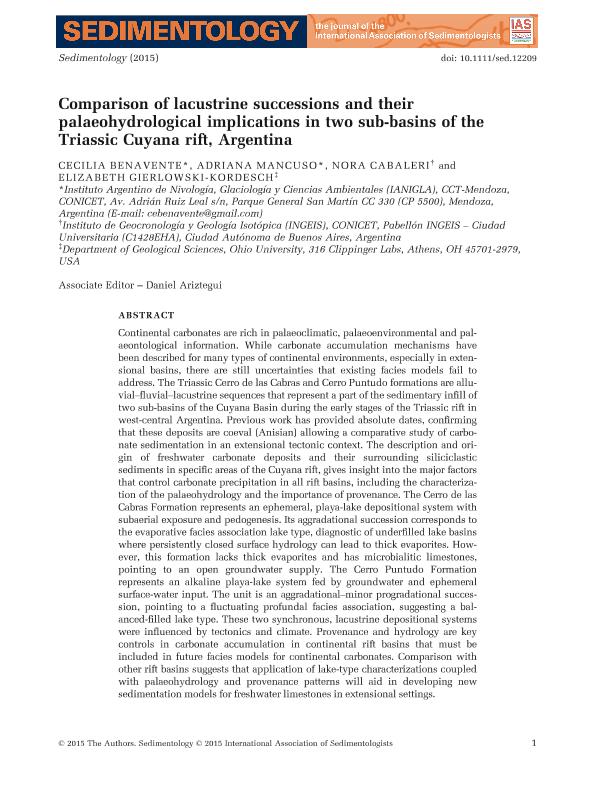Artículo
Comparison of lacustrine successions and their palaeohydrological implications in two sub-basins of the Triassic Cuyana rift, Argentina
Benavente, Cecilia Andrea ; Mancuso, Adriana Cecilia
; Mancuso, Adriana Cecilia ; Cabaleri, Nora Graciela
; Cabaleri, Nora Graciela ; Gierlowski Kordesch, Elizabeth
; Gierlowski Kordesch, Elizabeth
 ; Mancuso, Adriana Cecilia
; Mancuso, Adriana Cecilia ; Cabaleri, Nora Graciela
; Cabaleri, Nora Graciela ; Gierlowski Kordesch, Elizabeth
; Gierlowski Kordesch, Elizabeth
Fecha de publicación:
12/2015
Editorial:
Wiley Blackwell Publishing, Inc
Revista:
Sedimentology
ISSN:
0037-0746
Idioma:
Inglés
Tipo de recurso:
Artículo publicado
Clasificación temática:
Resumen
Continental carbonates are rich in palaeoclimatic, palaeoenvironmental and palaeontological information. While carbonate accumulation mechanisms have been described for many types of continental environments, especially in extensional basins, there are still uncertainties that existing facies models fail to address. The Triassic Cerro de las Cabras and Cerro Puntudo formations are alluvial–fluvial–lacustrine sequences that represent a part of the sedimentary infill of two sub-basins of the Cuyana Basin during the early stages of the Triassic rift in west-central Argentina. Previous work has provided absolute dates, confirming that these deposits are coeval (Anisian) allowing a comparative study of carbonate sedimentation in an extensional tectonic context. The description and origin of freshwater carbonate deposits and their surrounding siliciclastic sediments in specific areas of the Cuyana rift, gives insight into the major factors that control carbonate precipitation in all rift basins, including the characterization of the palaeohydrology and the importance of provenance. The Cerro de las Cabras Formation represents an ephemeral, playa-lake depositional system with subaerial exposure and pedogenesis. Its aggradational succession corresponds to the evaporative facies association lake type, diagnostic of underfilled lake basins where persistently closed surface hydrology can lead to thick evaporites. However, this formation lacks thick evaporites and has microbialitic limestones, pointing to an open groundwater supply. The Cerro Puntudo Formation represents an alkaline playa-lake system fed by groundwater and ephemeral surface-water input. The unit is an aggradational–minor progradational succession, pointing to a fluctuating profundal facies association, suggesting a balanced-filled lake type. These two synchronous, lacustrine depositional systems were influenced by tectonics and climate. Provenance and hydrology are key controls in carbonate accumulation in continental rift basins that must be included in future facies models for continental carbonates. Comparison with other rift basins suggests that application of lake-type characterizations coupled with palaeohydrology and provenance patterns will aid in developing new sedimentation models for freshwater limestones in extensional settings.
Archivos asociados
Licencia
Identificadores
Colecciones
Articulos(IANIGLA)
Articulos de INST. ARG. DE NIVOLOGIA, GLACIOLOGIA Y CS. AMBIENT
Articulos de INST. ARG. DE NIVOLOGIA, GLACIOLOGIA Y CS. AMBIENT
Articulos(INGEIS)
Articulos de INST.DE GEOCRONOLOGIA Y GEOLOGIA ISOTOPICA (I)
Articulos de INST.DE GEOCRONOLOGIA Y GEOLOGIA ISOTOPICA (I)
Citación
Benavente, Cecilia Andrea; Mancuso, Adriana Cecilia; Cabaleri, Nora Graciela; Gierlowski Kordesch, Elizabeth; Comparison of lacustrine successions and their palaeohydrological implications in two sub-basins of the Triassic Cuyana rift, Argentina; Wiley Blackwell Publishing, Inc; Sedimentology; 62; 7; 12-2015; 1771-1813
Compartir
Altmétricas



